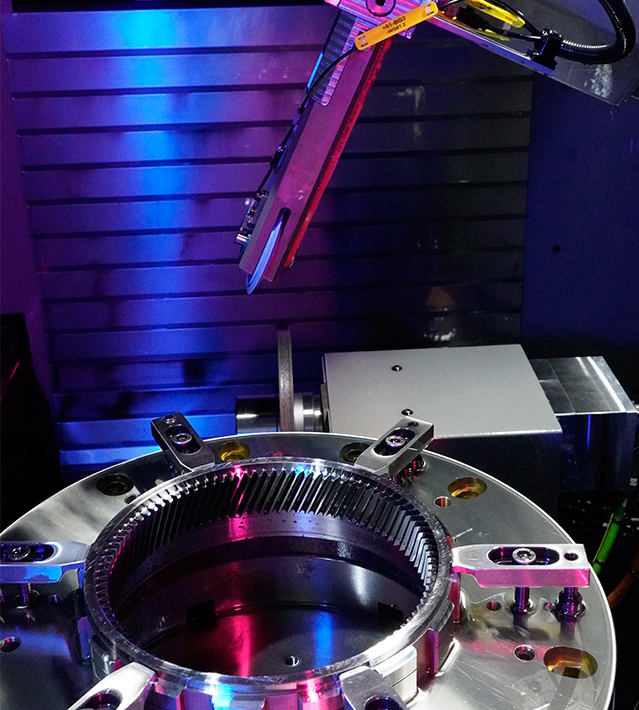Thermal management technology for power batteries
1、 Overview
Under the global trend of energy conservation and emission reduction, new energy vehicles have become a key direction for the development of the automotive industry.

Automotive thermal management is the overall coordination, optimization, and control of vehicle engine, air conditioning, battery, motor, and other related components and subsystems from the perspective of the entire vehicle, effectively solving vehicle thermal related problems, ensuring that each functional module is in the optimal temperature operating range, improving vehicle economy and power, and ensuring safe driving of the vehicle.
As the core component of new energy vehicles, the performance of power batteries is crucial to the overall performance of the vehicle. However, the performance of power batteries is significantly affected by temperature. For example, lithium-ion batteries can accelerate irreversible reactions such as SEI film decomposition and electrode material decomposition in high temperature environments, leading to rapid capacity decay and even thermal runaway, posing safety hazards; In low-temperature environments, the electrolyte ion conductivity decreases and the charge transfer impedance increases, resulting in a significant decrease in battery charging and discharging efficiency and a shortened range. According to research, when the operating temperature of the battery is maintained within the optimal range and the temperature difference between cells is small, the rate of battery capacity decay will be effectively reduced. Therefore, efficient battery thermal management technology has become the key to ensuring the performance of power batteries, extending their service life, and ensuring the safe operation of vehicles. It not only enhances the market competitiveness of new energy vehicles, but also has significant importance in promoting the sustainable development of the automotive industry.
2、 Classification of Battery Thermal Management
At present, thermal management systems on the market are mainly divided into three categories: air cooling, liquid cooling, and refrigerant direct cooling:
(1) Air cooled thermal management
Air cooling is a thermal management method that uses air as a cooling medium. According to the power source of air flow, it can be divided into active heat dissipation and passive heat dissipation. Active heat dissipation creates forced air circulation inside the battery pack through fans or blowers, taking away the heat generated by the battery; Passive heat dissipation relies on natural wind during vehicle operation to achieve heat dissipation. Some models such as Nissan Leaf pure electric vehicle and Jianghuai IEV5 pure electric vehicle adopt air cooling technology.
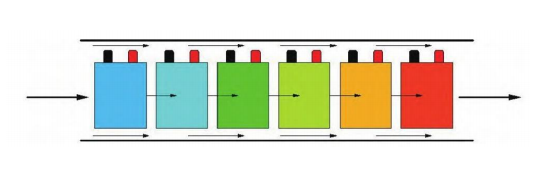
The air-cooled method has a simple structure, low cost, and high safety factor, but the specific heat capacity and thermal conductivity of air are low, resulting in limited cooling capacity and difficulty in meeting the heat dissipation needs of power batteries under high load conditions. It is also greatly affected by environmental temperature and vehicle speed, resulting in poor temperature uniformity and is not suitable for scenarios with strict heat dissipation requirements. Difficult to achieve precise control of battery temperature, generally suitable for scenarios with low heat dissipation requirements and small battery capacity
(2) Liquid cooled thermal management
Liquid cooled thermal management uses liquid as the cooling medium, and commonly used cooling liquids include ethylene glycol aqueous solution, water, etc. According to the contact method with the power battery, it can be divided into direct contact (immersion cooling) and indirect contact. Many models such as General Motors VOLT and Tesla Model S adopt liquid cooling technology. Direct contact cooling directly contacts the high thermal conductivity and high insulation cooling medium with the battery, avoiding the secondary heat exchange process, increasing the heat exchange area, and effectively improving the temperature uniformity of the system. However, its cost is high, liquid cooling adds extra weight, and later maintenance is difficult. Indirect contact cooling achieves cooling through secondary heat exchange between the cooling medium, heat exchange components, and power battery. It has relatively low requirements for the cooling medium, but the heat exchange performance is greatly affected by the heat exchange components, and the pipeline sealing requirements are extremely high. Once leaked, it can cause safety accidents. At the same time, additional power devices such as water pumps are required, which increases battery power consumption and affects the vehicle's endurance; In addition to completing cooling tasks, PTC heaters can also be added to the water circuit to achieve battery heating function under low temperature conditions.

(3) Direct cooling of refrigerant
Refrigerant direct cooling uses phase-change refrigerants (such as R134a, R1234yf, etc.) as the cooling medium, and its working principle combines indirect contact liquid cooling with traditional air conditioning systems. It has been applied in models such as BMW i3 and BYD Dolphin. This technology treats the heat exchange components in the system as evaporators in the air conditioning system, absorbing battery heat through saturated liquid-phase refrigerant and boiling it into gas-phase refrigerant to achieve power battery heat dissipation. Compared with traditional indirect liquid cooling, refrigerant direct cooling can be coupled with the passenger compartment thermal management system in the vehicle layout, reducing the coolant circulation loop and refrigeration unit heat exchange components, lowering costs and weight, and improving system safety. In addition, refrigerant direct cooling utilizes the high latent heat of vaporization of the refrigerant, resulting in a more rapid and efficient cooling effect, and is an important development direction to replace traditional indirect liquid cooling.
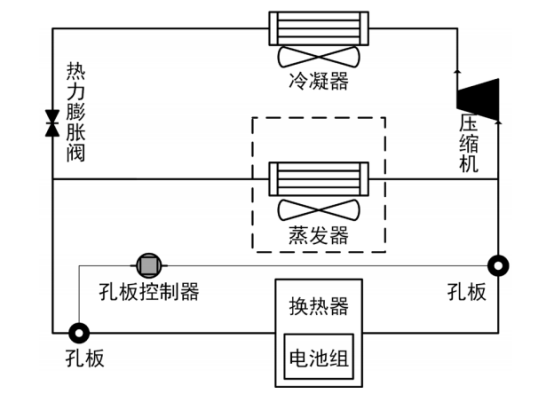
3、 Liquid cooled thermal management - Tesla thermal management technology
(1) Tesla Model S Thermal Management System
The Tesla Model S thermal management system mainly realizes four functions: battery cooling, battery heating, cabin thermal management, and motor electronic control cooling. By reasonably controlling the operation of each circuit, ensure that the battery operates within a suitable temperature range, and improve battery performance and lifespan; Simultaneously providing a comfortable temperature environment for the cabin, ensuring the comfort of the driver and passengers; It can also effectively cool the motor control system and ensure its stable operation.

The system consists of multiple components. The battery thermal management circuit includes an electronic water pump, a battery water-cooled plate Chiller、 Low temperature water tank W-PTC、 Electronic expansion valve, four-way valve, etc. Among them, the electronic water pump provides cooling fluid circulation power; The battery water-cooled plate is in direct contact with the battery to achieve heat exchange; Chiller cools the coolant by exchanging heat with the refrigerant in the air conditioning refrigeration circuit; W-PTC is used to heat the coolant when needed; Electronic expansion valve regulates refrigerant flow and controls the temperature of the chiller; The four-way valve realizes the series or independent operation of the motor thermal management circuit and the battery thermal management circuit to achieve the recovery of motor waste heat. The automotive air conditioning circuit includes an electric compressor, condenser, three-way valve, electronic expansion valve, evaporator W-PTC、 The warm air core, electronic fan, etc. are responsible for the cooling and heating of the cabin. The motor thermal management circuit includes an electronic water pump, a low-temperature radiator DC/DC、IPU、 Components such as motors and expansion kettles are mainly used for cooling motors and related power components.
In heating mode, when the battery needs to be heated up, if motor waste heat recovery is used, high-temperature coolant flows out of the motor thermal management circuit, enters the battery thermal management circuit through a four-way valve, and then flows through the battery water cooling plate to transfer heat to the battery. After that, the coolant passes through relevant components and returns to the motor thermal management circuit. If W-PTC heating is used, the coolant starts from the electronic water pump, enters the battery water cooling plate after being heated by W-PTC, heats the battery, and then recirculates back to the electronic water pump.
In cooling mode, the car air conditioning refrigeration circuit starts, the valve port on the right side of the three-way valve opens, and the electronic expansion valve regulates the flow of refrigerant through the chiller to reduce the chiller temperature. The low-temperature coolant starts from the electronic water pump, flows through the battery water-cooled plate to take away the battery heat, then enters the chiller for cooling, and then returns to the electronic water pump through the water tank and the stopped W-PTC.
(2) Model Y Thermal Management Technology Architecture
Model Y is based on Tesla's first and second generation battery thermal management technology, and the thermal management circuit has been further optimized in principle. On the basis of the previous generation, the system's integration and energy efficiency have been further improved. In addition to achieving basic battery cooling, heating, cabin thermal management, and motor electronic control cooling functions, the large integrated eight way valve and intelligent algorithm calibration have more efficiently distributed and recycled heat between various circuits, improving the vehicle's range and energy utilization efficiency.
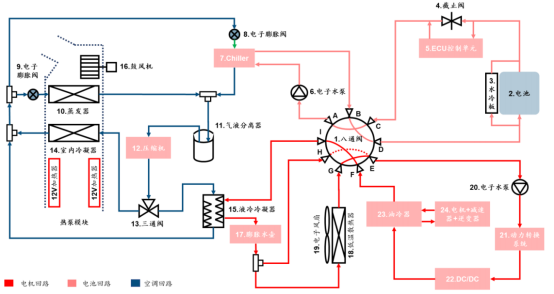
Model Y has introduced some new key components. The large-scale integrated eight way valve dynamically combines the heat pump air conditioning system, electric drive, and battery thermal management circuit, reducing pipeline usage and achieving more accurate heat distribution and recycling. Taking Model Y as an example, its thermal management system also includes a heat pump air conditioner based on R1234yf refrigerant. The heat pump recovers waste heat from the thermal management circuit, supplemented by low-pressure PTC and refrigerant recirculation technology, improving heating efficiency in low-temperature environments. In addition, the addition of the motor oil cooling module significantly improves the heat dissipation efficiency of the motor, meeting the cooling requirements for high-power operation of the motor. In terms of system composition, it also includes an electronic water pump Chiller、 The battery water cooling plate, four-way valve, four-way valve and other components work together to ensure the stable operation of the system.
In terms of heating, due to the cancellation of W-PTC, the battery pack is mainly heated by the residual heat of the motor. The coolant flows out from the electronic water pump above the Super bottle, and after being heated by components such as the charger, electronic control, and oil cooler, it enters the four-way valve and then enters the battery thermal management circuit from the electronic water pump below. It flows through the chiller and water-cooled plate to heat the battery.
In terms of cooling, when the battery needs to be cooled, the battery circuit using coolant and the air conditioning circuit using refrigerant exchange heat through a chiller. When the air conditioning circuit is cooling, the compressor compresses the refrigerant, which cools down in the condenser into a high-pressure liquid working fluid. It then passes through the shut-off valve and reaches the chiller, providing a cold source for the chiller. The coolant in the battery circuit circulates along the route of chiller electronic water pump water-cooled plate four-way valve port C four-way valve port B, exchanging heat with low-temperature refrigerant in the chiller to reduce the battery temperature.
4、 Battery refrigerant direct cooling and heating management system
As an important branch of thermal management in power batteries, battery refrigerant direct cooling technology relies on the use of phase change materials to directly absorb and transfer the heat generated by the battery, and achieve efficient temperature control through refrigerant circulation. The system mainly consists of components such as air conditioning compressor, condenser, throttling device (expansion valve), direct cooling plate, four-way valve, liquid storage tank, temperature sensor, and control unit. The air conditioning compressor is the core power component of the system, providing power for refrigerant circulation; The condenser is responsible for cooling and condensing high-temperature and high-pressure gaseous refrigerant into liquid form; The throttling device reduces the pressure of the refrigerant, turning it into a low-temperature and low-pressure gas-liquid mixture; The refrigerant undergoes four cycles of compression, condensation, expansion, and evaporation in a closed circuit, continuously carrying away the heat inside the battery pack.
The choice of refrigerant directly affects system performance. Currently, the mainstream use of Freon type working fluids such as R134a and R1234yf, which are liquid at room temperature and rapidly vaporize when entering the evaporator. The latent heat of phase change can reach over 200kJ/kg. The battery module and evaporator are designed with embedded irregular aluminum tubes, and the distance between the refrigerant flow channel and the battery cell is controlled within the range of 1.5-3mm to ensure the shortest heat conduction path. The temperature sensor monitors the voltage of each individual unit in real-time with an accuracy of 0.1 ℃. When the temperature difference exceeds the set threshold, the electronic expansion valve adjusts the refrigerant flow rate at a frequency of 0.5Hz, and cooperates with the variable frequency compressor to achieve precise temperature control of ± 0.5 ℃.
Compared to traditional liquid cooling systems, this technology has three major structural advantages: firstly, it eliminates the need for secondary heat exchange, reduces thermal resistance by about 40%, and can still maintain operating temperatures below 35 ℃ under peak battery power conditions; Secondly, the refrigerant directly contacts the surface of the battery to form an isothermal field, and the temperature difference inside the module can be controlled within 3 ℃, effectively delaying the lithium deposition phenomenon of the battery. Thirdly, the system volume is reduced by 30% compared to liquid cooling solutions, especially suitable for coupe models with limited chassis height. According to actual test data from a certain brand, at an ambient temperature of 45 ℃, when the battery pack using this technology is discharged continuously for 2C, the maximum temperature rise rate is only 0.8 ℃/min.
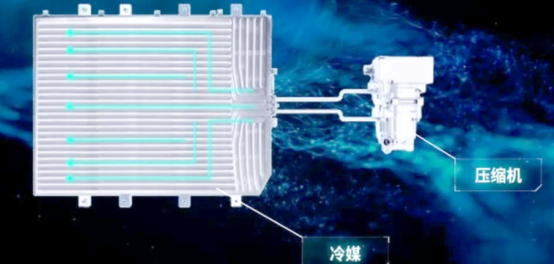
The main function of the refrigerant direct cooling system is to provide precise temperature control for the power battery. In high temperature environments, the battery temperature can be quickly reduced to prevent safety issues such as performance degradation or thermal runaway due to overheating, ensuring stable operation of the battery under high load conditions. In low-temperature environments, it can quickly increase battery temperature, improve battery low-temperature performance, enhance battery charging and discharging efficiency, and increase battery range. In addition, the system can achieve precise temperature balance of the battery pack, reduce temperature differences between various battery modules within the battery pack, avoid inconsistent battery performance caused by uneven temperature, and extend the service life of the battery.
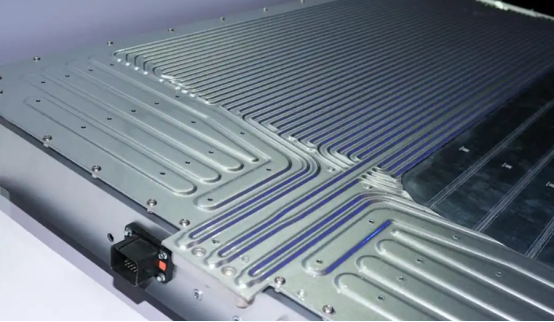
In cooling mode, the compressor compresses low-temperature and low-pressure gaseous refrigerant into high-temperature and high-pressure gaseous refrigerant, and then delivers it to the condenser. In the condenser, the refrigerant exchanges heat with the outside air, releases heat, and condenses into high-pressure liquid refrigerant. The high-pressure liquid refrigerant is throttled and depressurized by a throttling device (such as an expansion valve), and becomes a low-temperature and low-pressure gas-liquid mixture that enters the direct cooling plate. In the direct cooling plate, the low-temperature and low-pressure refrigerant absorbs the heat generated by the battery and evaporates into a gaseous state, thereby achieving cooling of the battery. The gaseous refrigerant is then sucked back by the compressor to complete the refrigeration cycle.
5、 Technological development trends
With the continuous advancement of new energy vehicle technology, battery thermal management technology is also developing towards high efficiency, intelligence, and integration. Efficiency requires further improvement in heat dissipation efficiency and energy utilization efficiency, while reducing energy consumption. For example, by optimizing the heat transfer structure and heat transfer medium, the heat transfer per unit volume can be increased. Intelligence utilizes advanced sensors, control algorithms, and artificial intelligence technology to achieve real-time and accurate monitoring and control of battery temperature. Automatically adjust thermal management strategies based on different operating conditions and usage environments of the battery to ensure that it is always in the best working condition. Integration refers to the deep integration of battery thermal management systems with other vehicle systems, such as air conditioning systems, power systems, etc., to achieve resource sharing and collaborative work, improve overall system performance and reliability, while reducing costs and space occupation.
Note: The data and images cited in the article are sourced from the internet


